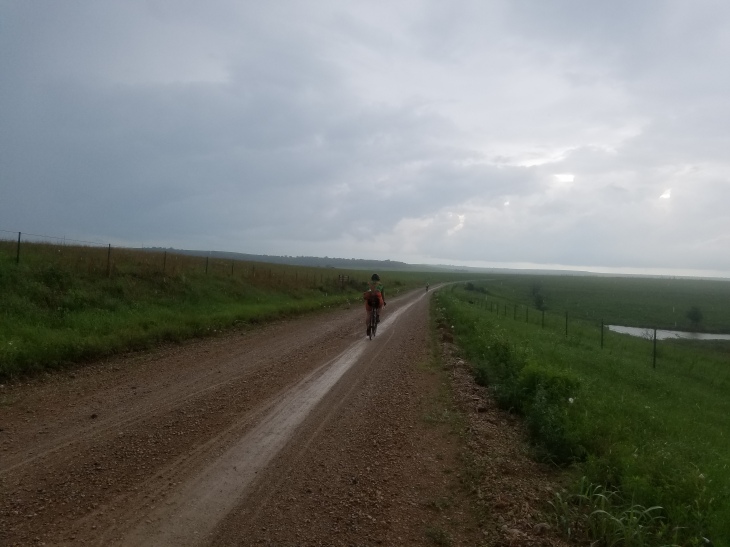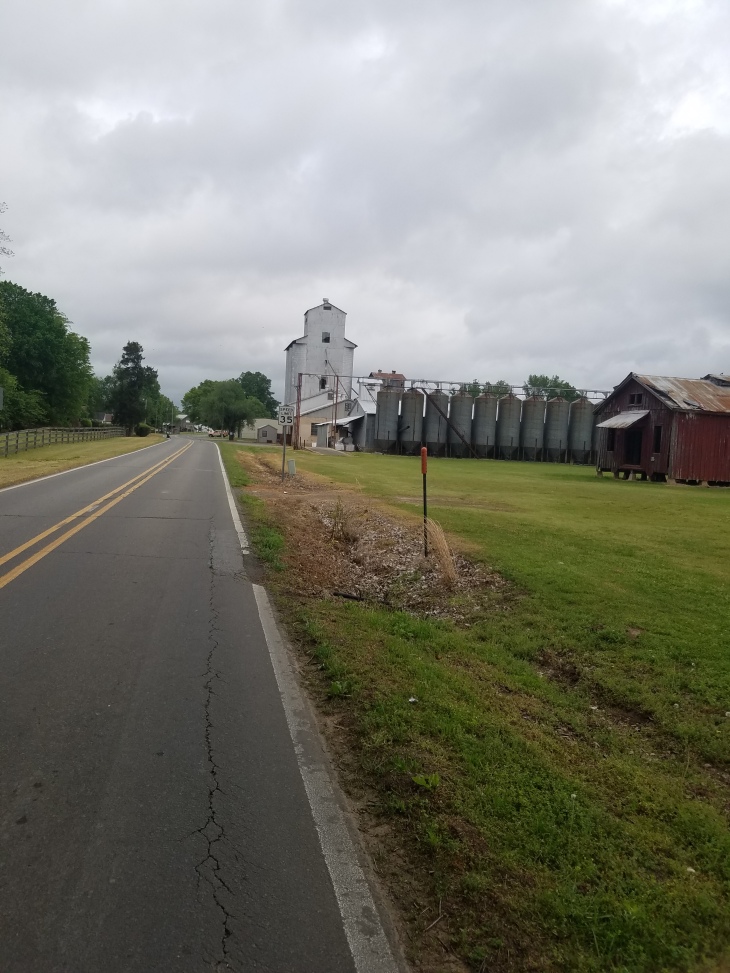Note: This post is about my second Dirty Kanza 200 experience on June 3, 2017.
It’s broken into seven parts:
Part I – Prep / Training
Prep / Training
Many changes from last year’s Part II – Prep / Training plan including…
Changes to the bike
Still riding the Willard.

Raleigh Willard I @ 4am on race day
With a few changes to the setup that worked quite well:
- Handlebars – Salsa cowbell type 3, double-wrapped, wider, not as deep in the drops (comfort), double-wrapped to reduce vibration and prevent a repeat from last year’s numbed fingers.
- Cassette – Shimano 12-36T – granny gear means staying in the saddle during climbs, adding weight to the rear tire preventing slippage. Not standing preserves energy reserves deeper into the day.
- Tires – Teravail Cannonball – 700×38 – shaves 2mm’s width from the tire with no downside. Even with goo tubes, they (seem to) roll a bit easier vs. last year’s Schwalbe Marathons.
Summary of changes to bike
Once again this bike gets me across the finish — in time. I did have a bit of trouble during the 3rd leg. The afternoon thundershowers brought with them mud and rocks getting into the gears. This caused them to grind (hence the name) and required frequent stops to flush. Otherwise a chain or derailleur surely would break, and did for those who didn’t pay heed.
These were extreme road conditions; I doubt anything but a single-speed would have done as well.

Mile 134 (3rd leg) of the 2017 dirty kanza and sloppy / muddy road conditions.
Training
Significant changes from last year. Here is my 2017 training log:
# Week Longest Day Total Miles 1. Feb 6 83 216 2. Feb 13 63 201 3. Feb 20 90 222 4. Feb 27 58 167 5. Mar 6 79 207 6. Mar 13 95 212 7. Mar 20 45 181 8. Mar 27 111 213 9. Apr 3 98 202 10. Apr 10 141 285 11. Apr 17 23 23 12. Apr 24 79 239 13. May 1 160 327 14. May 8 70 199 15. May 15 101 155 16. May 22 55 192 17. May 29 208 252
The strategy included the following:
- Every two weeks ride a bit further on the long day.
- Hold the longest day at least one month prior.
- Don’t ride long during the week.
- Hills, hills and more hills.
- Work on speed / intervals.
This made life easier as every other weekend I’d embark on a long training ride. Sawtoothing my way up to about 160 miles — at the beginning of May.
More hills and interval training (ugh), where things get pushed to limit, but actually spent fewer long days on the bike. I took it easy during the week with up to 120 miles logged between M-F.
Most of that training was pavement on the roads and trails around Little Rock.

Downtown Little Rock (LR)

North LR (from the river trail)
A lot of time spent outside of LR, in the mountains and deltas.

Harper’s loop
Here’s a descent down Thornburg Mountain:
Another coming off the backside of Wye mountain on Hwy 300:
There was one week grinding Kansas gravel outside Salina, including this century ride on the Native Stone route in Wabaunsee County.

Native Stone trail mile 19

Native Stone mile 84
Always remembering to take a break now and then…

@ Diamond Bear in NLR
Training Summary
I finished the race, shaving about an hour off last year’s time, but there’s room for improvement. Still, I felt pretty good after the ride, and recovered quicker than last year.
Hydration
After last year’s fiasco running dry during the 2nd leg, and almost DNFing, I was determined to change. I added a 2.5L camelbak to my 1.8L platypus bladder (in the framebag), along with two water bottles. I also paid attention to electrolytes on the long, sweaty rides.
Hydration Summary
Amazingly enough, even with all that water, I ran out about 10 miles from CP2 @ 95 miles. An improvement over last year, but not good enough.
If you get one thing from this post:
Bring plenty of water for that 2nd leg of DK!!! (more later).
Food
My nutrition plan also failed me last year with a bonk on the 2nd leg. This year I eased my foolish opposition to factory products.

I learned the hard way that nutrition is crucial on those long rides (2nd only to hydration), and started eating those syrupy goopy packages of food. No, I still don’t like, but to be successful on long rides, one must consume their calories — gradually and consistently. Eat too much at once and get sick. Too little and run out of gas. For me the optimum is about 100 calories every 10 miles or so, which allows me to keep going, seemingly indefinitely.
Food Summary
My nutrition plan was a success in 2017. I was able to eat, and stay energized, until the finish.
Next Post: Part II – Preamble
